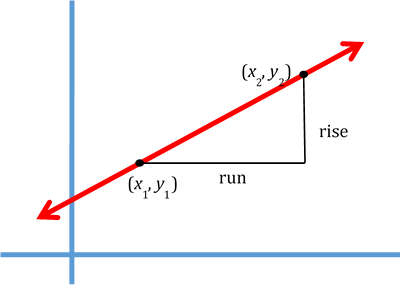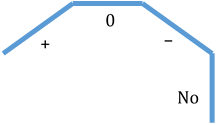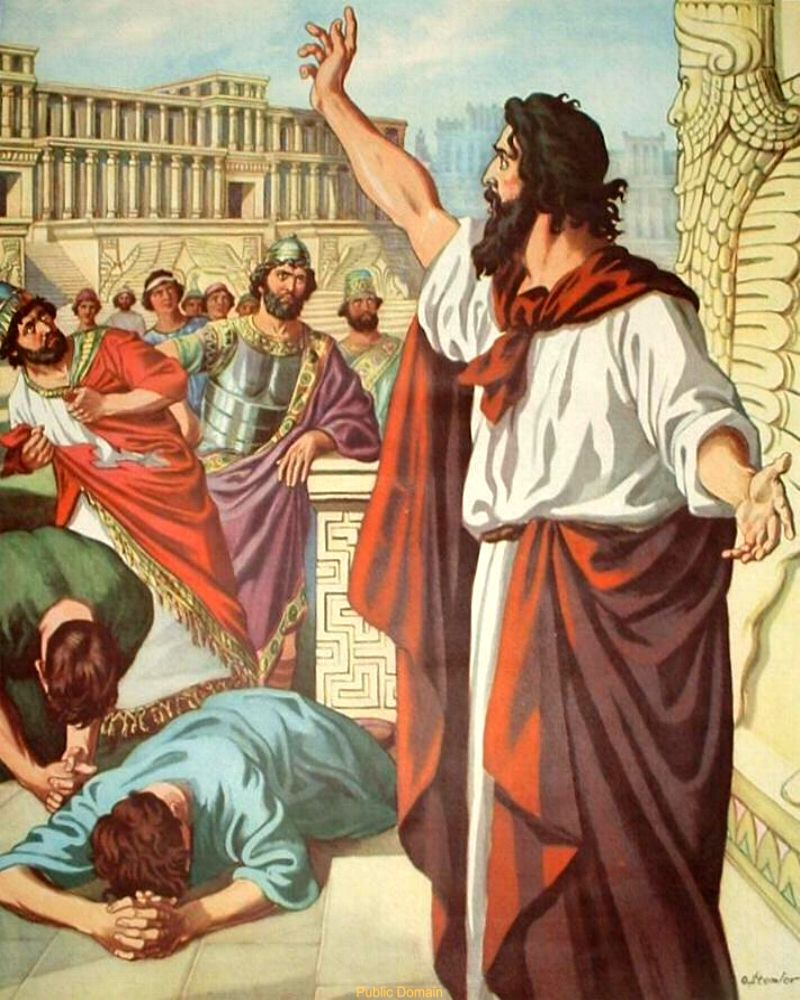
Algebra 2 by Richard Wright
Are you not my student and
has this helped you?
Objectives:
SDA NAD Content Standards (2018): AII.4.1, AII.4.2, AII.5.1, AII.5.3, AII.7.1

The steepness of a side of a mountainside is the slope. Skiers like to ski down steep slopes.
Slope describes how steep a graph of a line is from left to right. It is how much the y changes as the x changes.

$$ Slope = \frac{rise}{run} $$
$$ m = \frac{y_2-y_1}{x_2-x_1} $$
In real-life problems, slope is the same thing as rate of change because rate of change is how much one quantity changes as another changes. Think of a graph where the y-axis is measured in dollars and the x-axis is measured in years. The slope formula is y divided by x, so the new units would be dollars per year which is the rate by the which the amount of dollars changes every year.
As you move from left to right, a positive slope rises, a negative slope falls, zero slope is horizontal, and no slope (or undefined slope) is vertical.

$$ Slope = \frac{rise}{run} $$
$$ m = \frac{y_2-y_1}{x_2-x_1} $$
Find the slope of the line passing through the given points. Classify as rises, falls, horizontal, or vertical.
Solution
Fill in the slope formula with the points. Remember the y's go on top.
(1, 4), (3, 8)
$$ m=\frac{y_2-y_1}{x_2-x_1} $$
$$ m=\frac{8-4}{3-1} $$
$$ m=\frac{4}{2}=2 $$
It is a positive slope, so it rises.
(5, 2), (–3, 5)
$$ m=\frac{y_2-y_1}{x_2-x_1} $$
$$ m=\frac{5-2}{-3-5} $$
$$ m=-\frac{3}{8} $$
It is a negative slope, so it falls.
(3, 1), (–2, 1)
$$ m=\frac{y_2-y_1}{x_2-x_1} $$
$$ m=\frac{1-1}{-2-3} $$
$$ m=\frac{0}{-5}=0 $$
It is zero slope, so it is horizontal.

A scuba diver is 30 feet below the surface of the water 1 minute after he entered the water and 100 feet below the surface after 2.5 minutes. The suggested rate of change of depth is 30 ft/min. Is this diver following the recommendation?
Solution
Rate of change is the same as slope. Time is usually the independent, or x, variable to the depth will be the y variable. The two points would be (1, 30) and (2.5, 100).
$$ m=\frac{y_2-y_1}{x_2-x_1} $$
$$ m=\frac{100-30}{2.5-1}=\frac{70}{1.5}\approx46.7 $$
Since this is a word problem, the answer wanted is probably a decimal, so the diver’s rate of change of depth is 46.7 ft/min. Thus the diver is not following the recommendation.
Parallel lines are lines in the same plane that do not intersect. They go the same direction. Parallel lines have the same slope.

Perpendicular lines are in the same plane that intersect to form a right angle. The product of the slopes of perpendicular lines is −1. This means the slopes are negative reciprocals such as \(\frac{2}{3}\) and \(-\frac{3}{2}\).

Parallel line have the same slope.
m1 = m2
Perpendicular lines have slope whose product is –1. The slope are also negative reciprocals.
m1 · m2 = –1 or \(m_2 = -\frac{1}{m_1}\)
Tell whether the lines are parallel, perpendicular, or neither.
Solution
Find the slopes and compare them.
$$ \begin{array}{lrl}\text{Line 1:} & m_1=\frac{-4-8}{2-\left(-2\right)} & =-\frac{12}{4} = -3 \\ \text{Line 2:} & m_2=\frac{2-1}{-2-\left(-5\right)} & =\frac{1}{3} \end{array} $$
\(-3\cdot\frac{1}{3}=-1\) so the lines are perpendicular.
$$ \begin{array}{lrl} \text{Line 1:} & m_1=\frac{7-\left(-2\right)}{1-\left(-4\right)} & =\frac{9}{5} \\ \text{Line 2:} & m_2=\frac{5-\left(-4\right)}{3-\left(-1\right)} & =\frac{9}{4} \end{array} $$
Since the slopes are not the same, nor is their product −1, the lines are neither.
To write equations of lines:
Find the equation of the line through (1, 2) and (–2, 4).
Solution
Find the slope:
$$ m=\frac{y_2-y_1}{x_2-x_1} $$
$$ m=\frac{4-2}{-2-1}=-\frac{2}{3} $$
Fill the slope, \(-\frac{2}{3}\), and a point (1, 2) into y = mx + b and solve forb.
$$ 2=-\frac{2}{3}\left(1\right)+b $$
$$ 2=-\frac{2}{3}+b $$
$$ 2+\frac{2}{3}=b $$
$$ b=\frac{6}{3}+\frac{2}{3}=\frac{8}{3} $$
Fill m and b into y = mx +b.
$$ y=-\frac{2}{3}x+\frac{8}{3} $$
Write the equation of the line given in the graph.

Solution
The slope can be found from the graph. Counting rise and run from (2, −2) to (3, 1) gives a rise of 3 and a run of 1.
$$ slope = m = \frac{rise}{run} = \frac{3}{1} = 3 $$
Fill the slope, 3, and a point (3, 1) into y = mx + b and solve forb.
1 = 3(3) + b
−8 = b
Fill m and b into y = mx +b.
y = 3x − 8
Find the slope of the line passing through the given points. Classify as rises, falls, horizontal, or vertical.
Tell whether the lines are parallel, perpendicular, or neither.
Write the equation of the line with the given information.

Problem Solving

Mixed Review